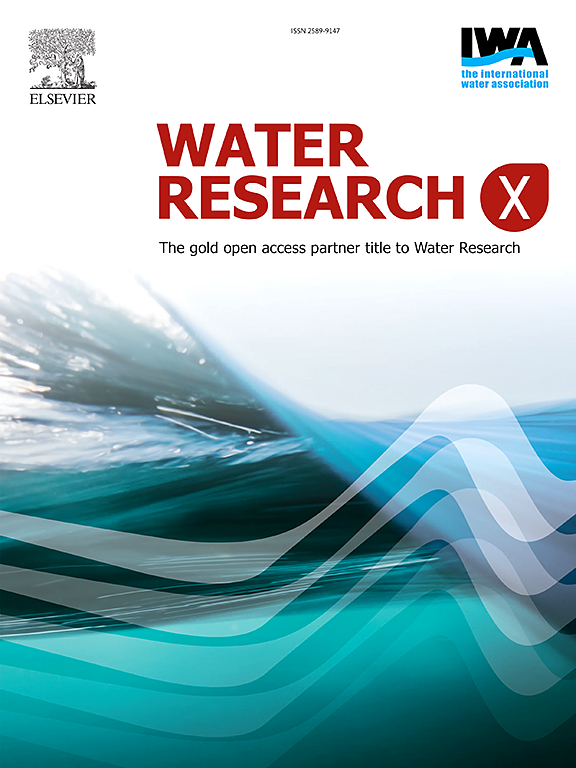High fecal indicator bacteria in temperate headwater streams at baseflow: implications for management and public health
IF 8.2
2区 环境科学与生态学
Q1 ENGINEERING, ENVIRONMENTAL
引用次数: 0
Abstract
Fecal indicator bacteria (FIB) in rivers and streams serve as key markers of public health risks, but factors influencing spatiotemporal FIB variation in headwater streams at baseflow have received insufficient attention. We analyzed a 12-year dataset of FIB concentrations collected from 118 watersheds in the Delaware River Basin of the eastern United States across seasons to establish baseline conditions and investigate how landscape (watershed size and land cover) and in-stream (e.g., temperature and particulates) environmental variables relate to spatiotemporal FIB variations. We found that most probable number (MPN)-derived FIB levels in baseflow at 86 % to 96 % of sites (for Escherichia coli and Enterococcus, respectively) were above human health regulatory limits for primary contact during the recreational season. Variables affecting FIB dynamics included watershed size, seasonal variations in stream temperature, total particulate carbon and nitrogen in the water, and land cover types – specifically, the relative extent of forested, developed, and agricultural areas. Based on watershed size, smaller headwaters contained higher recreational period FIB concentrations than larger rivers. Headwater FIB concentrations were related to land cover, with lower concentrations observed in forested watersheds, and higher concentrations in developed and agricultural watersheds. Microbial source tracking suggested that FIB originated from human and bovine sources in headwaters with developed or agricultural land cover. FIB levels tended to be lower in non-recreational seasons (winter, spring, and fall) in small headwater streams. In addition to human, cow and other animals, we speculate that FIB survival and turnover in local environments might also cause FIB occurrence. These findings help guide choices of indicators to address fecal contamination of rivers and streams and prioritize restorative actions at the landscape scale.

基流温带水源中高粪便指示细菌:对管理和公共卫生的影响
摘要河流中粪便指示菌(FIB)是公共卫生风险的重要标志,但影响河流源流基流FIB时空变化的因素尚未得到足够的重视。我们分析了美国东部特拉华河流域118个流域12年来不同季节的FIB浓度数据集,以建立基线条件,并研究景观(流域大小和土地覆盖)和河流(如温度和颗粒物)环境变量与FIB时空变化的关系。我们发现,在86%至96%的地点(分别为大肠埃希菌和肠球菌),基流中最可能数量(MPN)衍生的FIB水平高于休闲季节初次接触的人类健康监管限值。影响FIB动态的变量包括流域大小、河流温度的季节变化、水中总颗粒碳和氮以及土地覆盖类型——特别是森林、发达地区和农业区的相对范围。根据流域大小,较小的源头比较大的河流含有更高的休闲期FIB浓度。水源FIB浓度与土地覆盖有关,森林流域的浓度较低,发达流域和农业流域的浓度较高。微生物源追踪表明,FIB起源于发达或农业土地覆盖地区的人类和牛源。在非消闲季节(冬、春、秋),小源流中FIB水平较低。除人、牛等动物外,我们推测FIB在局部环境中的生存和周转也可能是FIB发生的原因。这些发现有助于指导选择指标,以解决河流和溪流的粪便污染问题,并在景观尺度上优先考虑恢复行动。
本文章由计算机程序翻译,如有差异,请以英文原文为准。
求助全文
约1分钟内获得全文
求助全文
来源期刊

Water Research X
Environmental Science-Water Science and Technology
CiteScore
12.30
自引率
1.30%
发文量
19
期刊介绍:
Water Research X is a sister journal of Water Research, which follows a Gold Open Access model. It focuses on publishing concise, letter-style research papers, visionary perspectives and editorials, as well as mini-reviews on emerging topics. The Journal invites contributions from researchers worldwide on various aspects of the science and technology related to the human impact on the water cycle, water quality, and its global management.
 求助内容:
求助内容: 应助结果提醒方式:
应助结果提醒方式:


